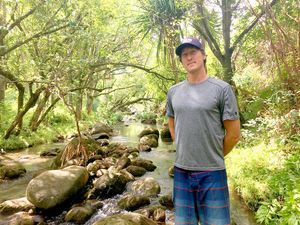WAIPA, KAUAI — O’opu fish have come back to spawn in the Waipa Stream after dense thickets of hau bush were removed, helping to restore the water flow.
The fish are integral to Hawaiian culture, with four species of o’opu that were favored for eating and the fifth that was believed to be related to the mo’o, or lizard gods.
They’ve been missing from Waipa Stream since water diversions that came with Kauai’s development changed stream flow and things like hau bush to took over.
Rosener and his team at the Waipa Foundation have also planted ferns and native hibiscus to increase bank stability and provide shade. Further from the bank they’ve planted food-bearing and medicinal plants like ‘awa and breadfruit.
“It’s a bit like a food forest,” Rosener said. “We want to plant native plants, and if we have food-bearing plants here, too, we can harvest when we come over here as well.”
The stream restoration project is one piece of an overarching goal at the Waipa Foundation to holistically restore the entire ahupua’a, mauka to makai.
The 1,600 acres, owned by Kamehameha Schools and leased by Waipa Foundation, is home to gardens and taro patches and a certified kitchen. It’s a place for community members to gather and learn about watershed management.
Alongside stream restoration, the Waipa Foundation is working on water quality testing in the Waipa ahupua’a to understand their own water quality, as well as contribute to a solution for the high level of bacteria reported by both Surfrider Foundation Kauai and the state Department of Health in Hanalei Bay.
Monitoring the coral reefs in the bay is also part of their ahupua’a management strategy.
“As we’re doing the stream restoration, we’re documenting the changes that are happening,” Rosener said. “And as we change the streams, we’re expecting changes in the coral reefs.”
While the Waipa Stream is just one of many inputs into Hanalei Bay, the holistic approach to managing the entire ahupua’a extends to nearshore waters, including the reefs.
“It’s a puzzle and we’re better understanding how each piece fits together,” he said. “Healthier streams and corals mean more fish and that means better opportunities for fishermen.
The funds are centered on stream restoration work, best agriculture practices, and forest restoration.
Part of that money is also going toward replacing cesspools with septic tanks, with the goal of replacing all of them in the watershed within the next two years.
“They’re (DOH) focused on preventing polluted runoff and enhancing water quality,” Rosener said.
Waipa Foundation is also starting a reef monitoring project with the state Department of Aquatic Resources to document the reef health quarterly.
From the origins of the water in the Waipa ahupua’a to the bay that catches the stream at its end, Waipa Foundation is restoring traditional practices and finding new ways to maintain a healthy watershed.
And they’re helping people while they’re at it.
“It’s mutually beneficial, we’re getting environmental restoration and it benefits the human community, too,” Rosener said.
The Waipa Foundation occasionally hosts work days, typically on Saturdays, where residents and visitors to Kauai are welcome to lend a hand.
On an August weekend, for example, the focus for the work day was be turning one of the taro patches in the valley into a plot of native wetland plants.
“We’re using it as a biofilter because the water goes from the taro to the ditch to the stream and then to the bay,” Rosener said. “So it’ll go through here from the taro, before going into the ditch.”
To find out more info, check out the Waipa Foundation website at waipafoundation.org/
Written for The Garden Island Newspaper, published Aug 25, 2017. Photos by Jessica Else.

Leave a comment